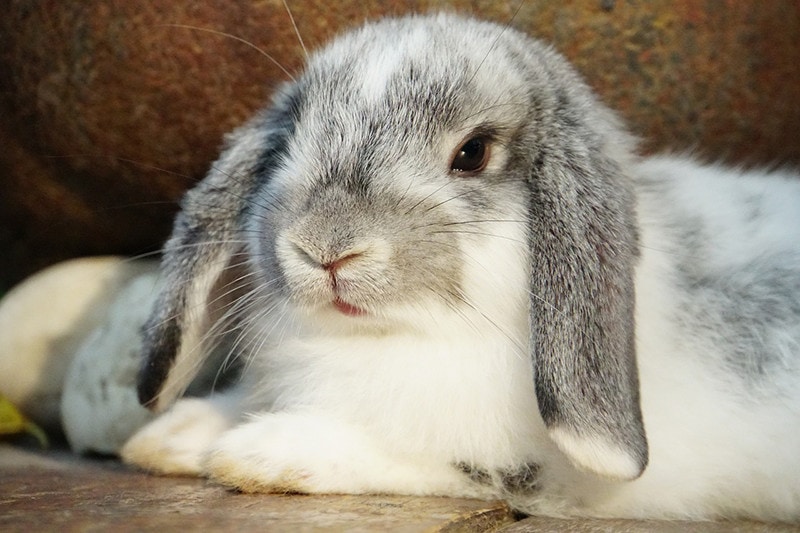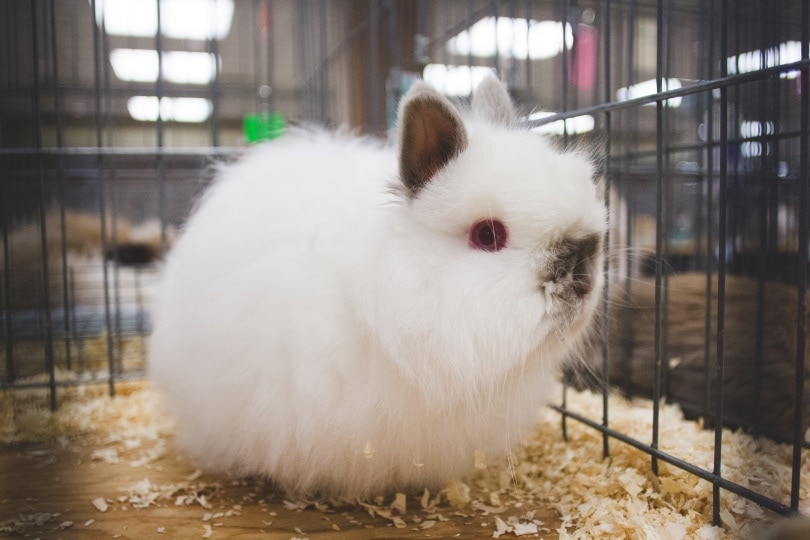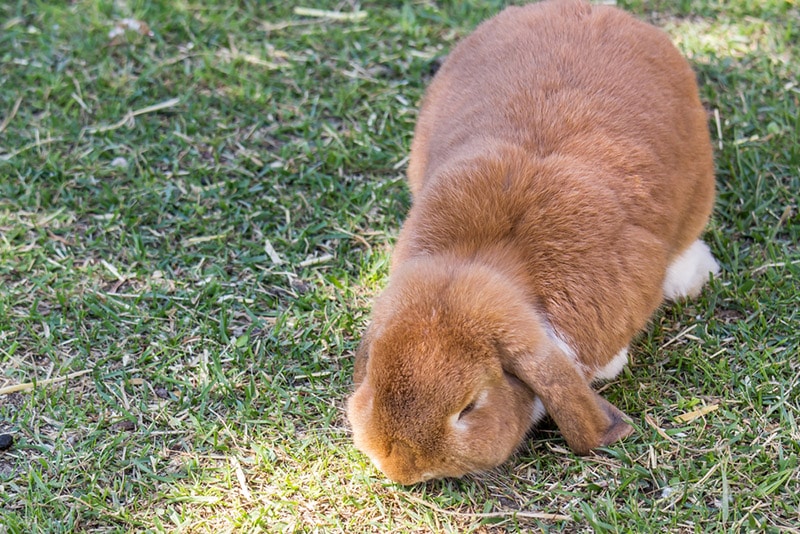12 Types of Dwarf Rabbits (With Pictures)
Updated on

Dwarf rabbits are a small breed of domestic rabbits with a compact body shape. Mini rabbits can weigh as little as 2 pounds, but some species, like the Lop Rabbit, weigh up to 5 pounds.
Dwarf rabbits stay small throughout their lives. They are just like their larger counterparts but need special care.
Planning to adopt a dwarf rabbit? Here are some dwarf rabbits and whether they may be good pets.
The 12 Types of Dwarf Rabbits
1. Mini Lop Rabbit

| Weight: | 5.5 to 7.7 pounds |
| Life Expectancy: | 5 to 7 years |
A Mini Lop Rabbit is one of the most popular dwarf rabbits despite its recent development in the 1970s. The rabbit has a short body with a rounded frame.
Although the Lop Rabbit is small, it has strong musculature. Its head is also bigger than the rest of the body. The breed gets its name from the lop-sided hanging appearance of its ears.
Lop Rabbits make good pets, but they’re not suitable for all homes. They do best in quiet environments without children.
2. Holland Lop

| Weight: | 2 to 4 pounds |
| Life Expectancy: | Up to 10 years |
The Holland Lop has a short and stocky body, with ears hanging down the sides of the head. It weighs around 2 to 4 pounds when fully grown and comes in different colors, such as chocolate, black, and tortoise.
If you plan to keep a Holland Lop as a pet, note that they require a high-fiber diet. They prefer eating fresh veggies and hay for nutrition. Avoid keeping a Holland Lop as a pet if you live in areas with extreme temperatures.
3. Columbia Basin Pygmy Rabbit

| Weight: | 1 pound |
| Life Expectancy: | 3 to 5 years |
The Columbia Basin Pygmy Dwarf Rabbit is among the smallest rabbits. It has a stocky, round body and short ears. The rabbit has soft gray fur with a white underside.
It’s rare to find this breed anymore due to its infrequent breeding. The breed almost went extinct in the 1990s. Even the rabbits you find today are not purebred. Due to the rarity of the breed, it would be hard to find a Columbia Basin Pygmy Rabbit to keep as a pet.
4. Jersey Wooly Dwarf Rabbit

| Weight: | Up to 3.3 pounds |
| Life Expectancy: | 6 to 9 years |
The Jersey Wooly Rabbit was bred in New Jersey, which is where the breed gets its name from. Besides being small and cute, the rabbit is also very affectionate and decile, making a good pet.
Unlike some other breeds, Jersey Wooly Rabbits do not get aggressive. They are also small and light, meaning they don’t need too much space.
5. Lionhead Rabbit

| Weight: | Up to 5 pounds |
| Life Expectancy: | 7 to 9 years |
As the name gives away, the Lionhead Rabbit has a splendid fur mane. The breed’s ears can be as long as 7 inches but often get hidden by the fur. Some varieties also come with shorter and more erect ears.
Lionhead Rabbits shed most of their “mane” when they reach adulthood. So, if you want to keep them as pets, be prepared for the shedding. These rabbits come in different coat colors and are easy to care for.
6. Mini English Angora Rabbit

| Weight: | 5 to 7.5 pounds |
| Life Expectancy: | 5 to 8 years |
The Mini English Angora Rabbits are popular for their thick coats and tender appearance. They have short ears and flat heads. Unlike other Angora Rabbits, the dwarf varieties have fur on their faces and ears.
Mini Angora Rabbits make great pets since they are gentle, calm, and love to be cuddled. But they require extensive grooming to keep their fur from matting or tangling.
7. Britannia Petite Rabbit
| Weight: | Up to 2.5 pounds |
| Life Expectancy: | 6 to 10 years |
The Britannia Petite Rabbit has many coat colors, including sable, otter, black, chestnut, and white. Its life expectancy is 6 to 10 years, making it a long-term companion. The ideal diet for a Britannia Petite Rabbit comprises vegetables, hay, and pellets.
The rabbit’s arched body is its most prominent characteristic. It also has a slightly raised belly and a wedge-shaped head. The ears stand erect and are short.
Britannia Petite Rabbits need a lot of exercise to maintain good behavior and physical health. So, if you want to keep them as pets, you must be prepared to create an ample play area for them.
8. Miniature Cashmere Lop Rabbit

| Weight: | 4 to 5 pounds |
| Life Expectancy: | Up to 8 years |
The Miniature Cashmere Lop Rabbit has many color forms and likes eating hay, fruits, veggies, and pellets. It’s known for its super soft coat and long ears. When you look at the rabbit from the side, its head appears curved.
While the Miniature Cashmere Lop Rabbit makes a good pet, its coat requires a great deal of grooming. Otherwise, mats and tangles might form in your pet’s beautiful “cashmere” coat.
Be mindful of the breed’s health issues too. Some of these rabbits suffer from spinal problems, so proper care is essential.
9. Dwarf Hotot

| Weight: | Up to 3 pounds |
| Life Expectancy: | 7 to 10 years |
The Dwarf Hotot is known for its soft fur and cute appearance. It was originally bred in France in the early 1900s. The Dwarf Hotot’s ears lay on the back of its head and tend to perk up quickly.
Although the breed is small, it has a big appetite. So, be prepared to feed it well if you keep it as a pet. But also note that Dwarf Hotots are prone to obesity and require optimal daily exercise.
- Related read: How Much Do Dwarf Hotot Rabbits Cost?
10. Dutch Dwarf Rabbit

| Weight: | Up to 2.5 pounds |
| Life Expectancy: | 7 to 10 years |
Dutch Dwarf Rabbits may have a cuddly appearance but do not like being picked up or played with. Don’t be fooled by their size because they are quite strong. The rabbits are muscular and have large heads compared to their bodies.
Dutch Dwarf Rabbits don’t make the best pets, especially in homes with children. They also have high exercise needs and are super quick, which means they’re easy to lose sight of.
11. Mini Satin Rabbit

| Weight: | Up to 5 pounds |
| Life Expectancy: | 5 to 8 years |
The Mini Satin Rabbit has a satin-life coat and medium-length ears. Its musculature can be lean to muscular, depending on the diet it’s fed. The rabbit is also very active and loves to explore.
Mini Satin Rabbits are good-natured pets with laid-paid temperaments. But the recessive gene that gives them satin fur is rare. So, you’ll have a hard time finding this bunny to keep as a pet.
12. American Fuzzy Lop Rabbit

| Weight: | 3 to 4 pounds |
| Life Expectancy: | 5 to 8 years |
The American Fuzzy Lop Rabbits have a cat-like muzzle with distinct markings on their nose. They also have eye circles and tinted eyes that make them look adorable. Their ears hang on the sides of their faces.
While these rabbits might be good pets, they are prone to a couple of health conditions you should be aware of. For example, they are susceptible to rabbit mites, ticks, fleas, and fur ball formation in the stomach.
Do Dwarf Rabbits Make Good Pets?
Whether a dwarf rabbit makes a good pet or not will depend on its type. Some mini rabbits are easy to care for and have a gentle temperature. Meanwhile, others may be aggressive and have significant attention or exercise needs.
When choosing a rabbit to keep as a pet, you should consider the following:
- Dietary needs
- Temperament
- Susceptibility to health conditions
- Exercise needs
If you have kids, you should also consider whether the breed suits them.
 Conclusion
Conclusion
Dwarf rabbits are little furballs of cuteness that can make a good addition to your family. But you should be familiar with the characteristics and requirements of the bunny you want to adopt before bringing it into your home.
Related reads:
Featured Image Credit: Jorgeie009, Pixabay











